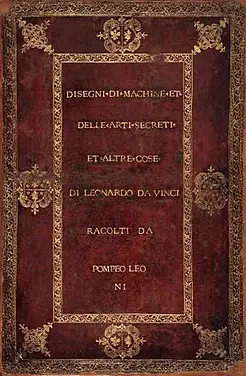
The Codex Atlanticus is a fascinating collection that combines Leonardo da Vinci‘s diverse works, encompassing subjects ranging from art to science.
If you’ve ever struggled to find comprehensive resources on Leonardo’s vast contributions, this blog post will guide you through the intricacies of his most extensive compilation.
You can expect an in-depth look into some of his most intriguing drawings and writings.
The Codex Atlanticus is not just any collection; it is the most extensive compilation of Leonardo’s writings and drawings. It consists of 12 volumes that provide valuable insight into his genius.
Leonardo’s work in this collection includes engineering diagrams, anatomy studies, artistic sketches, and even fables inspired by Florentine literature.
This makes it a treasure trove for historians, artists, and science enthusiasts looking to explore Leonardo’s innovative mind.
The collection, located at the Veneranda Biblioteca Ambrosiana in Milan, has been made more accessible thanks to a digital platform that allows users to browse all 1,119 pages of his notebook.
This interactive experience allows visitors to explore the evolution of Leonardo’s thoughts in either Italian or English, providing an engaging way to connect with his legacy through a modern lens.
Codex Atlanticus Overview
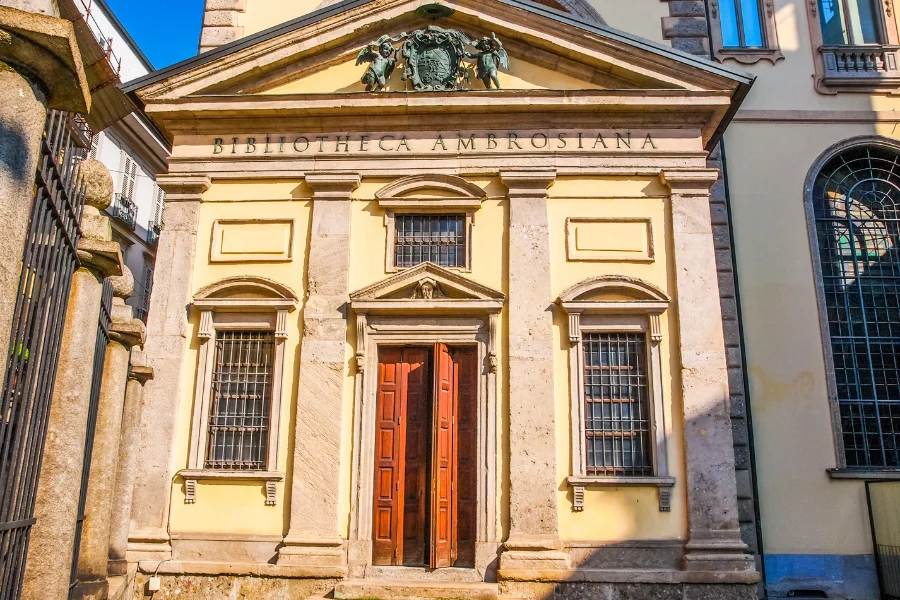
The Codex Atlanticus is a comprehensive collection of Leonardo da Vinci’s works, covering a range of subjects, from his scientific studies to artistic concepts. This codex is renowned for its intricate drawings and extensive writings, offering a deep insight into Da Vinci’s genius.
Historical Context
The Codex Atlanticus was compiled during the late Renaissance, a period marked by a renewed interest in art and science. It spans from 1478 to 1519 and encompasses Leonardo da Vinci’s life and work. The collection includes notes and sketches that reflect the broad scope of Leonardo’s intellect.
Initially kept in a private collection, the codex was eventually preserved at the Ambrosiana Library in Milan, thanks to the efforts of sculptor Pompeo Leoni. By organizing these texts and illustrations, Leoni ensured that future generations could explore and understand Leonardo’s multifaceted contributions.
The Library has played a crucial role in maintaining the integrity and accessibility of the codex, offering scholars a window into Leonardo’s world.
Content and Themes
The Codex Atlanticus covers a wide range of topics. Leonardo da Vinci explored a wide range of domains, from engineering diagrams to detailed anatomical sketches.
His notes on flying machines, weaponry, and even musical instruments highlight his inventive spirit.
One notable entry is the Vitruvian Man, depicting ideal human proportions.
His fascination with mechanics is evident in designs like the da Vinci perpetual motion machine.
Each page of the codex reveals Leonardo’s blend of art and science, demonstrating his use of drawing to innovate and discover.
Leonardo da Vinci

Leonardo da Vinci was a true polymath who excelled in the arts and sciences. His life, art, and scientific studies continue to inspire people worldwide.
Biographical Sketch
Leonardo da Vinci was born on April 15, 1452, in Vinci, a town in Italy near Florence. He was the illegitimate son of a notary, Piero da Vinci, and a peasant woman named Caterina. Showing early talent, he was apprenticed to the renowned artist Andrea del Verrocchio in Florence.
By the age of 20, Leonardo was established as a member of the Florentine Painters’ Guild. Over the years, he worked for influential patrons like Ludovico Sforza in Milan. He spent his final years in France under the patronage of King Francis I, where he passed away in 1519.
Artistic Contributions
Leonardo da Vinci made extraordinary contributions to art. One of his most famous works is the “Mona Lisa,” renowned for its enigmatic expression. His “The Last Supper” is hailed for its composition and detail.
He also created the “Vitruvian Man,” a symbol that represents the blend of art and science.
His sketches and paintings often explored human anatomy and natural phenomena, bridging the gap between art and science. His legacy endures in the timeless appeal of his works and innovative techniques, as seen in the Trattato della Pittura (Treatise on Painting).
Scientific Inquiries
Da Vinci’s scientific inquiries were vast and ahead of his time. As reflected in his detailed sketches, he explored engineering, anatomy, and physics.
His notebooks, like the Codex Hammer, reveal studies on topics such as the perpetual motion machine.
He also investigated bird flight and human anatomy, as documented in his Codex on the Flight of Birds.
Leonardo’s insatiable curiosity and efforts to intertwine the arts and sciences made him a visionary. His manuscripts, including the Codex Atlanticus, remain invaluable to scholars.
Manuscript Composition
The Codex Atlanticus is a remarkable collection of Leonardo da Vinci’s diagrams, sketches, and writings. It offers valuable insight into his engineering, anatomy, and artistic ideas.
Compilation Process
The Codex Atlanticus is the largest collection of Leonardo da Vinci’s manuscripts. It includes 1,119 paper leaves assembled from various sources over time.
Pompeo Leoni compiled these pages in the late 16th century and gathered them into twelve leather-bound volumes. The collection has become a treasure trove of da Vinci’s innovative thoughts and designs.
Leonardo’s notebooks were dismembered and reorganized into this compilation within the Codex Atlanticus. The pages contain well-known works, such as The Vitruvian Man, and lesser-known studies.
This process involved selecting pieces that best represented Leonardo’s diverse interests and talents. The Biblioteca Ambrosiana played a crucial role in preserving and enhancing the accessibility of this collection over time.
Materials and Techniques
Leonardo da Vinci employed a range of materials and techniques to create the pages in the Codex Atlanticus.
The manuscripts feature sketches drawn with ink on paper in different sizes, from small notes to large sheets.
Leonardo often wrote in mirror script, a technique he believed would help protect his privacy and ideas.
Aside from his technical drawings, the Codex contains artistic sketches, anatomical studies, and even fables written by Leonardo.
Leonardo’s use of paper and ink was innovative, allowing for detailed and dynamic illustrations. This allowed him to express ideas in engineering, anatomy, and art with precision and creativity.
Preservation and History
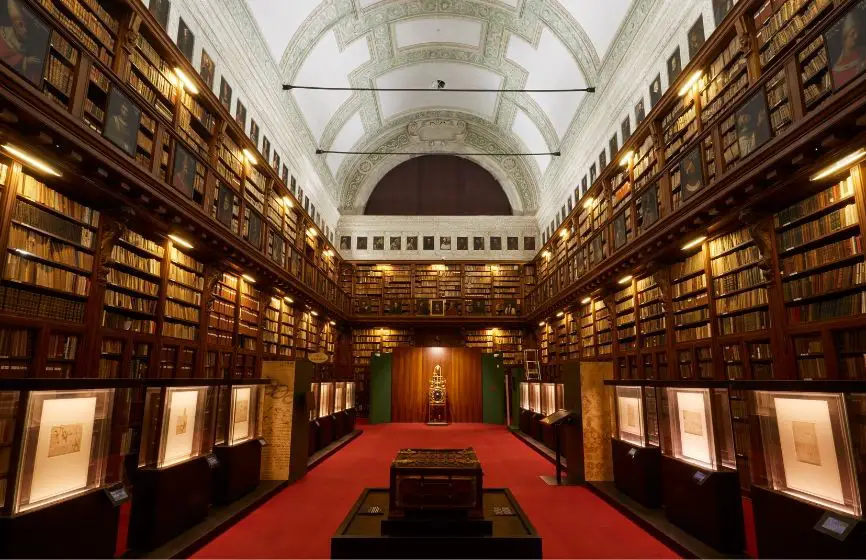
The Codex Atlanticus, which showcases Leonardo da Vinci’s genius, is housed at the Ambrosiana Library in Milan. Preservation efforts have been challenging and enlightening, revealing the intricacies of maintaining such a vast and valuable collection.
Restoration Efforts
Restoration of the Codex Atlanticus has been a complex and ongoing endeavor. In the 1970s, significant restoration work was undertaken by the Laboratorio del Libro Antico, based at the Abbey of Grottaferrata.
This process involved rebinding the collection into 12 volumes, each containing 1,119 folios. In 2006, an issue with mold in various colors, including black and red, was discovered.
Experts from the Opificio delle Pietre Dure in Florence conducted detailed examinations to mitigate the damage. Such efforts are crucial for maintaining the integrity of da Vinci’s invaluable manuscripts.
Display and Access
The Ambrosiana Library offers access to the Codex Atlanticus in a manner that strikes a balance between public engagement and preservation.
The library often displays selected pages in special exhibitions, allowing the public to appreciate da Vinci’s work.
Efforts to digitize the collection, such as offering online access, have improved its availability to scholars and enthusiasts worldwide.
Academics and researchers can study the codex in depth without compromising the fragile condition of the original documents, a balance critical to both preservation and education.
Categorization of Drawings
The Codex Atlanticus contains a rich collection of Leonardo da Vinci’s work. These drawings encompass a range of interests, including engineering, anatomy, and architecture. Each category showcases his genius and curiosity, presenting detailed studies and inventive ideas.
Engineering Designs
Among the Codex Atlanticus, Leonardo da Vinci’s engineering designs shine with creativity and a forward-thinking approach.
He was fascinated by machines and mechanics, which led to numerous sketches of inventions, such as the famous Da Vinci perpetual motion machine.
His designs include complex gears, pulleys, and even early concepts of flying machines.
Although not all designs were fully realized in his time, they laid the groundwork for future technological advancements. His work bridged the gap between imagination and practicality, showing his ability to envision new possibilities.
Anatomical Studies
Leonardo’s anatomical studies in the Codex offer profound insights into human and animal bodies. His detailed and precise drawings made a significant contribution to the field of anatomy.
These studies include muscles, bones, and internal organs, illustrating his deep interest in understanding life scientifically.
While other contemporaries ventured into similar studies, Leonardo’s skill in combining art with science was unmatched.
Architectural Plans
Leonardo also explored architectural planning. His sketches in the Codex Atlanticus range from grand urban layouts to detailed building components. These drawings reflect his interest in geometric precision and aesthetic harmony. They demonstrate his ability to think big, contemplating the organization of entire cities, as seen in his Plan of Imola.
His bold yet practical proposals aimed to improve urban living conditions, showcasing forward-thinking in city planning. The detailed work reveals both his artistic nature and intellectual depth, pushing the boundaries of traditional architecture.
Cultural Impact
The Codex Atlanticus has notably influenced Renaissance art and the study of mechanics, showcasing Leonardo Da Vinci’s genius and deep understanding of various fields.
Influence on Renaissance Art
Leonardo da Vinci’s works in the Codex Atlanticus had a profound influence on Renaissance art. His detailed anatomical sketches provided artists with valuable insights into the human body, shaping how figures were represented. Although not included in this codex, the Vitruvian Man reflects his broader influence on human proportion and geometry.
Leonardo’s exploration of perspective and light significantly impacted painting techniques. He also adopted a scientific approach to art, encouraging artists to observe nature closely.
Leonardo’s integration of science and art in the Codex inspired countless artists to adopt similar methods. The codex is housed in the Ambrosiana Library, ensuring its continued study and preservation of its influence.
Legacy in the Study of Mechanics
The Codex Atlanticus also made significant contributions to mechanical studies. It contains a wealth of diagrams related to machines, illustrating da Vinci’s fascination with mechanics and innovation. His sketches of devices, such as weight-driven clocks and flying machines, inspired future engineers.
As seen in the codex, Leonardo’s exploration of perpetual motion machines fueled later scientific inquiries. His blend of art and engineering demonstrated the power of interdisciplinary study. These ideas can be explored through digital platforms that offer insights into the codex’s mechanical content.
Digitalization and Modern Study
The Codex Atlanticus provides a unique glimpse into Leonardo da Vinci’s mind. Modern technology allows broader access and deeper insight into these manuscripts than ever before. Digitalization plays a central role in preserving and analyzing these extensive works.
Online Archives
The Codex Atlanticus has been digitized, allowing global access to its detailed pages. Through platforms like the Biblioteca Ambrosiana, users can explore Leonardo da Vinci’s sketches, engineering diagrams, and writings. This online availability makes researching and appreciating his work more manageable for academics and enthusiasts.
Many websites feature interactive elements and high-resolution images to enhance understanding. Features like zoomable images enable viewers to examine intricate details that would be overlooked in physical formats. These digital archives help protect fragile original documents while expanding accessibility.
Scholarly Analysis
Digital versions of the Codex Atlanticus have opened new avenues for scholarly analysis. Researchers can easily compare Leonardo’s work with his other writings, such as the Codex Leicester, or the Codex Madrid. Advanced software tools facilitate intricate studies of his Vitruvian Man and other famous works.
Moreover, digitalization has led to collaborations between scholars and technologists, enabling innovative approaches such as data visualization to bring fresh perspectives to the interpretation of Leonardo da Vinci manuscripts. These collaborations bridge the gap between historical research and cutting-edge technology, deepening our appreciation and understanding of Leonardo’s genius.
5 Key Facts About the Leonardo da Vinci Codex Atlanticus
This is the largest collection of Leonardo da Vinci’s drawings and notes in existence
No other collection holds more original documents by Leonardo than the Codex Atlanticus. It consists of 1,119 sheets, most of which are drawn or written on both sides.
This is the first page of the manuscript. On the left (below) is a curious naval weapon: a platform with sixteen cannons mounted, capable of covering an entire area with its shells. On the right are special devices for measuring distance traveled: the two on the left measure miles, while the one on the right counts steps.



Another fascinating detail to note is that the left column is one of the rare examples of Leonardo writing from left to right, while in the right column, one can observe his typical mirror writing.
Leonardo da Vinci did not assemble it
At the end of the 16th century, the Milanese sculptor Pompeo Leoni recovered a consistent number of Leonardo’s treatises from the heirs of Giovan Francesco Melzi, a faithful student of Leonardo. Leoni began work on two large volumes, roughly separating drawings that dealt primarily with technical and scientific subjects from those that focused on anatomical and artistic subjects. The former became the Codex Atlanticus, while the latter became the Windsor Collection.
The inscription on the old codex cover reads, “Machine and Art Drawings, Secrets and Other Things of Leonardo da Vinci, Collection of Pompeo Leoni.”
Why is it called Atlanticus?
The name Atlanticus has nothing to do with the Atlantic or any esoteric, mystical content hidden within its pages. It was called the Atlanticus because of its size: when assembling it in the late 16th century, Leoni pasted Leonardo’s treatises onto large sheets of paper in the same format as those used in geographic atlases.
This famous map of Europe is exciting because it shows concrete indications of Pompeo Leoni’s actions and processes in organizing Leonardo da Vinci’s papers: the missing part around the Brittany peninsula is now part of the Windsor collection (RL 12444 verso).
The reverse of the miniature Windsor painting shows the missing part of Breton. At the same time, the obverse depicts the figure of a youth, a theme more suitable for the second series of Leoni’s collection, a more “artistic” one.
It is stored in the Biblioteca Ambrosiana, Milan, since 1637
In 1637, Marquis Galeazzo Arconati, a nobleman from Milan, donated his impressive collection of artwork and manuscripts to the Biblioteca Ambrosiana, which had been established 30 years earlier by the Archbishop of Milan, Cardinal Federico Borromeo.
In just a few decades, the library’s fame spread throughout Europe for its unique collections covering all fields of knowledge, its openness to dialogue with other cultures, and its innovative approach to the public.
Leonardo spent many years in Milan, from 1482 to 1499 and from 1506 to 1513. This plan of the city of Milan dates back to the master’s second stay in Milan and accurately depicts the position of the ancient city gate behind the castle, as well as the waterway.
Napoleon brought it to France
In 1796, Napoleon’s troops conquered Milan, and the valuable collection was confiscated and taken to Paris. It remained in the Louvre for 17 years until the Congress of Vienna in 1815 ordered the return of all works of art stolen by Napoleon to their rightful countries of origin.
Controversies and Mysteries
The Codex Atlanticus is a fascinating collection of Leonardo da Vinci’s works, but it is not without controversy. One of the key mysteries surrounds a controversial sketch believed to depict a bicycle. Some scholars argue that this drawing was added much later, casting doubt on its authenticity.
Leonardo da Vinci’s Codex Atlanticus has also faced physical challenges. Historians and researchers have debated whether to dismantle its twelve volumes for better conservation. A top expert contends that separating the pages would help preserve and display them, but the issue remains contentious.
Recent discoveries of strange marks on Leonardo da Vinci’s Codex Atlanticus have sparked debates. These marks, appearing centuries after Leonardo’s time, fuel speculation about their origin. Experts are examining whether they signify damage or possess historical significance.
Preserving the Codex Atlanticus in the Ambrosiana Library also raises concerns. This vast collection includes Leonardo’s ingenious ideas and drawings. Some propose relocating certain sections to ensure better access for scholars, but such plans have yet to gain consensus.
Final Thoughts
The Codex Atlanticus is a remarkable compilation of Leonardo da Vinci’s genius. It encompasses various topics, including engineering, anatomy, and art. This collection showcases Leonardo’s diverse interests and profound insights.
The Codex Atlanticus is the largest collection of his works, with 1,119 pages. It includes sketches and writings from 1478 to 1519, covering a significant portion of his life and ideas and reflecting the depth of his intellect.
Leonardo’s studies in the Codex highlight his innovative ideas about flight, weaponry, and even musical instruments. They also reveal his scientific curiosity in subjects such as mathematics and botany. This provides a glimpse into his creative thought processes.
The Codex contains technical drawings, fables, and literary thoughts inspired by Da Vinci’s Florentine background. Da Vinci shared his qualifications with the Duke of Milan, outlining his skills in military engineering, which provided insight into his career ambitions.
The Codex Atlanticus’s enduring value lies in its ability to inspire modern thinkers and creators. It remains a testament to Leonardo’s impact on art, science, and innovation. The connection to Da Vinci’s inventions illustrates his forward-thinking contributions, which continue to influence many fields today.
Frequently Asked Questions
The Codex Atlanticus is a vast collection of Leonardo da Vinci’s work that offers insight into his innovative ideas. It is a significant cultural artifact that encompasses a wide range of subjects, including art, science, and engineering.
What is the meaning of Codex Atlanticus?
The Codex Atlanticus is a collection of drawings and writings by Leonardo da Vinci. The name “Atlanticus” refers to its large size, similar to an atlas. This collection comprises over 1,100 pages, covering a wide range of subjects.
Can you see the Codex Atlanticus?
Yes, the Codex Atlanticus is housed at Milan’s Biblioteca Ambrosiana. Parts of it are often displayed to the public. Visitors can view these exhibits in Milan to explore da Vinci’s works firsthand.
Who owns the Codex Atlanticus?
The Codex Atlanticus is part of the collection at the Biblioteca Ambrosiana in Milan. This library is its primary custodian, maintaining and preserving these valuable documents.
What is the Codex of Leonardo da Vinci?
Leonardo’s codices are collections of his notes and sketches. The Codex Atlanticus is the largest and most comprehensive collection, showcasing many of his ideas and inventions.
Why is the Codex so important?
The Codex Atlanticus is crucial because it reveals Leonardo da Vinci’s ingenuity. It covers many subjects, offering insight into his thinking process and contributions to science and art.
What is a codex in Christianity?
In Christianity, a codex refers to an ancient manuscript in book form. The term is often associated with early copies of biblical texts from the early Christian period.
Did Leonardo da Vinci have children?
Leonardo da Vinci had no known children. He remained unmarried throughout his life, focusing on his work and studies.
What is the codex used for?
The Codex Atlanticus is a historical record of Leonardo da Vinci’s diverse interests, encompassing plans for machines, scientific observations, and artistic sketches, which provide insight into his creative mind.
What is the oldest codex of the Bible?
The Codex Sinaiticus, dating back to the 4th century, is one of the oldest known complete copies of the Bible. It is a key historical document for biblical studies.
What does the codex stand for?
A codex generally refers to ancient manuscripts compiled in book format. In antiquity, this format replaced scrolls, making them easier to read and reference.

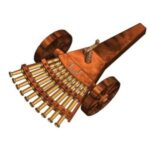
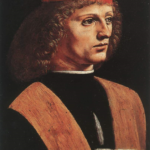
 Leonardo Bianchi,
the creator of Leonardo da Vinci's Inventions.
Thank you for visiting
Leonardo Bianchi,
the creator of Leonardo da Vinci's Inventions.
Thank you for visiting